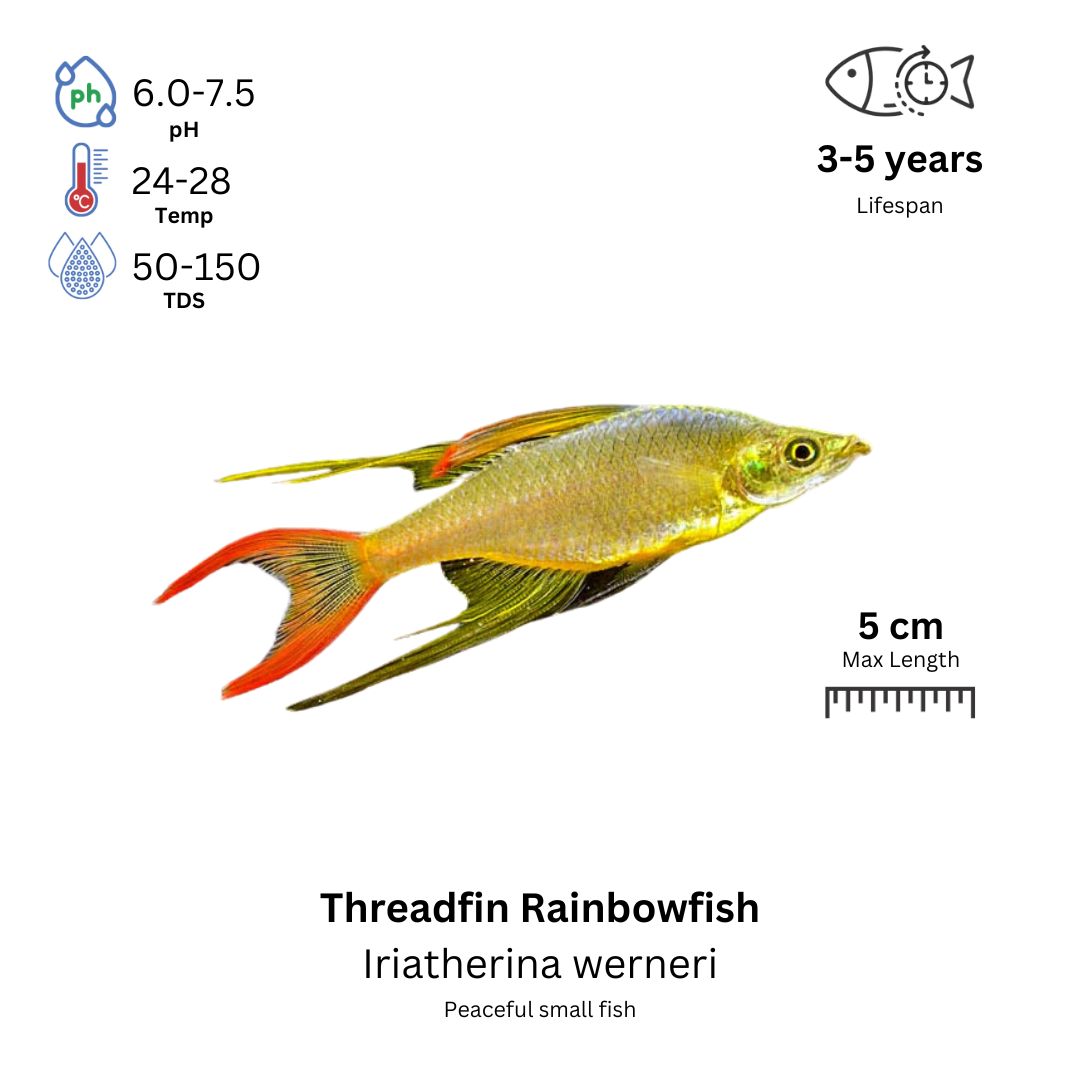Threadfin Rainbowfish: Species Profile
The Threadfin Rainbowfish (Iriatherina werneri) is a captivating freshwater species celebrated for its delicate, elongated fins and shimmering colors. Originating from the slow-moving waters of Australia and New Guinea, this fish is a prized addition to aquariums for its peaceful demeanor and graceful appearance.
Species Overview
- Common Names: Threadfin Rainbowfish, Featherfin Rainbowfish
- Scientific Name: Iriatherina werneri
- Adult Size: Approximately 1.2 to 1.6 inches (3 to 4 cm)
- Life Expectancy: Up to 4 years
Characteristics
- Family: Melanotaeniidae
- Origin: Australia and New Guinea
- Social: Peaceful, shoaling
- Tank Level: Top to midwater
- Minimum Tank Size: 15 gallons
- Diet: Omnivore
- Breeding: Egglayer; moderately challenging in captivity
- Care Level: Moderate
- pH: 6.0 to 7.0
- Hardness: 7 to 19 dGH
- Temperature: 75–82°F (24–28°C)
Origin and Distribution
Threadfin Rainbowfish are native to the freshwater swamps, lagoons, and slow-flowing rivers of Australia and New Guinea. They thrive in shallow, heavily vegetated waters, often associated with floating lily pads and abundant aquatic plants.
Colors and Markings
This species is distinguished by its slender body adorned with iridescent hues ranging from light brown to olive green. Males exhibit elongated, thread-like fins that can extend beyond their body length, displaying colors from dark brown to orange-red at the tips. Females, while less vividly colored, possess a subtle elegance with shorter fins.
Tankmates
Threadfin Rainbowfish are peaceful and do well in community tanks with other non-aggressive species. Suitable tankmates include:
- Small tetras
- Rasboras
- Corydoras catfish
- Otocinclus
- Shrimp
It’s advisable to avoid housing them with larger, aggressive fish or fin-nippers that might damage their delicate fins.
Habitat and Care
To replicate their natural habitat:
- Tank Setup: Provide a well-planted aquarium with open swimming areas. Incorporate fine-leaved plants, floating vegetation, and driftwood to offer hiding spots and mimic their natural environment.
- Water Parameters: Maintain stable water conditions within the recommended pH and hardness ranges. Regular water changes are essential to keep the environment clean and healthy.
- Lighting: Moderate lighting is preferred, which can be achieved with floating plants to diffuse light.
Diet and Feeding
Threadfin Rainbowfish are omnivorous and have small mouths, so they require appropriately sized food. A balanced diet includes:
- High-quality micro-pellet or crushed flake food
- Live or frozen foods such as brine shrimp, daphnia, and cyclops
- Occasional vegetable matter like finely chopped spinach
Feed them small portions multiple times daily, ensuring they consume the food within a few minutes to prevent overfeeding and water quality issues.
Gender Differences
Males are generally more colorful with significantly elongated fins, especially the first dorsal, second dorsal, anal, and pelvic fins. Females have shorter fins and a more subdued coloration.
Breeding
Breeding Threadfin Rainbowfish in captivity can be moderately challenging:
- Breeding Tank: Set up a separate tank with fine-leaved plants or spawning mops. Maintain slightly acidic to neutral water with a temperature around 80°F (27°C).
- Spawning: Introduce a conditioned male and female pair. Males will display their fins and perform a courtship dance to entice females. Spawning typically occurs among plants, with the female scattering eggs that adhere to vegetation.
- Raising Fry: After spawning, remove the adults to prevent them from eating the eggs. Eggs hatch within 7–10 days, and fry can be fed infusoria or commercially prepared fry food until they are large enough to accept standard foods.
Further Research
For those interested in similar species, consider exploring:
- Forktail Blue-eye (Pseudomugil furcatus)
- Celebes Rainbowfish (Marosatherina ladigesi)
- Dwarf Rainbowfish (Melanotaenia maccullochi)
These species share comparable care requirements and can coexist harmoniously in a community aquarium.
FAQ
- How many Threadfin Rainbowfish should be kept together? It’s best to keep them in groups of at least six to promote natural shoaling behavior and reduce stress.
- Are Threadfin Rainbowfish suitable for beginners? They require stable water conditions and a peaceful environment, making them more suitable for aquarists with some experience.
- Can Threadfin Rainbowfish live with other fish? Yes, they can coexist with other peaceful, similarly sized fish. However, avoid housing them with larger or aggressive species to prevent fin damage.
By providing appropriate care and a suitable environment, Threadfin Rainbowfish can be a graceful and colorful addition to any freshwater aquarium.


Reviews
There are no reviews yet.